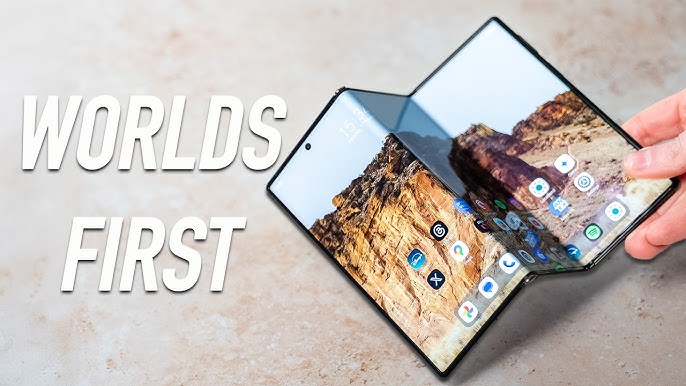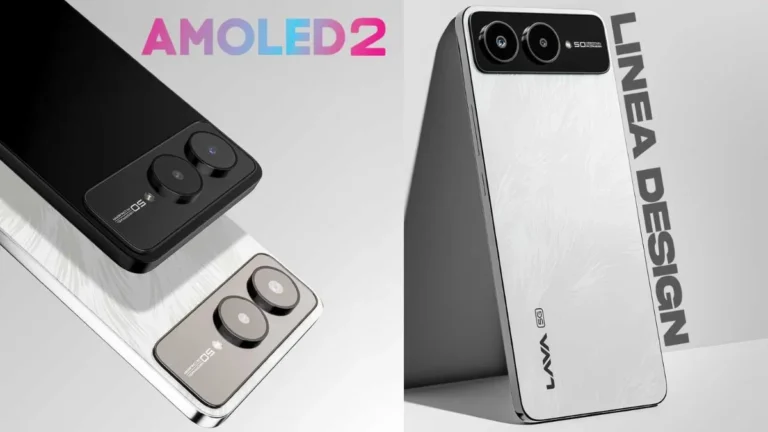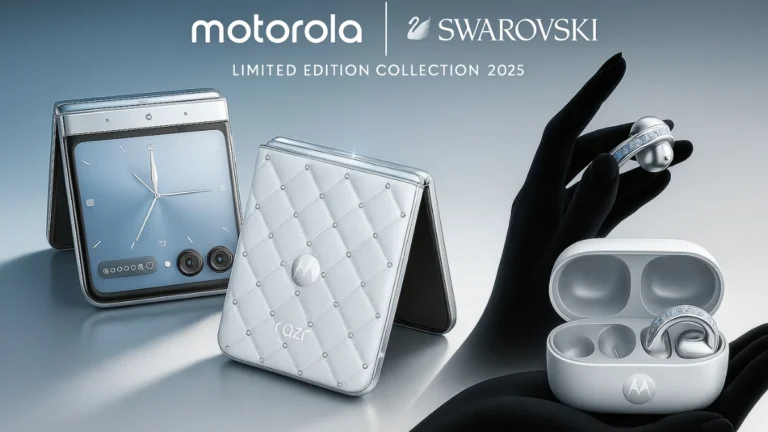
The Huawei Mate XT stands out as the world’s first tri-fold smartphone, marking a bold leap in mobile innovation. Unlike traditional foldables, which offer only two configurations, the Mate XT unfolds into three distinct modes—smartphone, tablet, and a full-sized display—bringing unmatched versatility. Its design is not just a technological experiment but a true game-changer in mobile design, merging portability with productivity. By pushing the boundaries of what a smartphone can be, the Huawei Mate XT redefines user expectations and sets a new benchmark for the foldable industry.
What Makes the Huawei Mate XT Unique?
The Huawei Mate XT delivers unmatched flexibility with its three distinct form factors. In its compact mode, it works like a standard 6.4-inch smartphone, making it easy to handle and carry in your pocket. Unfold it once, and you get a 7.9-inch tablet-style screen, perfect for multitasking, reading, or streaming content. Fully opened, the device expands into a 10.2-inch display, giving you near-laptop productivity in the palm of your hand.
Despite this versatility, the Huawei Mate XT maintains an impressively sleek profile. When fully unfolded, it measures just 3.6 mm in thickness, which is thinner than many traditional tablets. Even when folded down, it remains a manageable 12.8 mm thick, making it surprisingly portable for a tri-fold device. This combination of adaptability and slim design sets the Huawei Mate XT apart as a revolutionary piece of mobile engineering.
Also Read: Google Pixel 10 Series Launched: Price & Specs Revealed
Huawei Mate XT Build Quality & Design
The Huawei Mate XT is crafted with a design that balances luxury and engineering precision. Its dual-hinge mechanism ensures smooth folding and unfolding while maintaining durability across thousands of bends. The exterior features a vegan leather back paired with gold-accented trims, giving the device a sophisticated and premium aesthetic that stands out in the foldable market.
Despite its advanced tri-fold design, the Huawei Mate XT remains impressively portable. Weighing only around 298 grams, it is lighter than most tablets and even comparable to some conventional smartphones. This makes it surprisingly comfortable to hold and carry, especially considering the expansive 10.2-inch display it can unfold into. The combination of elegance, lightness, and functionality positions the Huawei Mate XT as both a fashion statement and a technological milestone.
Huawei Mate XT Display Experience
The Huawei Mate XT takes the foldable display experience to the next level with its seamless transitions between modes. Whether you’re switching from the compact smartphone layout to the tablet mode or expanding it into the full 10.2-inch screen, the shift feels fluid and natural, without the lag or distortion that early foldables often suffered from.
At the core is an ultra-thin glass OLED panel engineered for flexibility and durability, delivering rich colors, deep blacks, and crisp visuals. The display supports a 90 Hz refresh rate, ensuring smooth scrolling, responsive touch, and an overall premium viewing experience.
While foldable phones are often criticized for their visible crease, the Huawei Mate XT keeps it subtle and unobtrusive, allowing for more immersive viewing. Combined with minimal bezels, the device maximizes screen real estate, making everything from gaming to streaming feel cinematic.
Also Read: Lava Blaze AMOLED 2 Debuts with Sony Cam, 5000mAh
Huawei Mate XT Performance & Battery

Under the hood, the Huawei Mate XT is powered by the Kirin 9010 processor, a flagship-grade chipset built to handle demanding multitasking and AI-driven operations with ease. Coupled with up to 16 GB of RAM and 1 TB of internal storage, the device is designed for power users who need both speed and space, whether for gaming, editing, or heavy productivity.
Fueling this powerhouse is a robust 5,600 mAh battery, optimized to support its massive tri-fold display. Charging is equally impressive, with 66 W wired fast charging that can top up the device in under an hour, and 50 W wireless charging for convenient, cable-free power-ups.
In real-world terms, the Huawei Mate XT easily delivers a full day of usage on mixed tasks like calls, browsing, and media streaming. However, constant use in tablet mode—with the 10.2-inch screen fully active—does drain the battery more quickly, making fast charging a crucial feature for heavy users.
Huawei Mate XT Camera Prowess
The Huawei Mate XT is not just about its futuristic design—it also packs a powerful triple-lens camera system that rivals flagship smartphones. The setup includes a 50 MP main sensor for sharp, detailed shots, a 12 MP ultrawide lens for capturing expansive landscapes, and a 12 MP telephoto lens with 5.5× optical zoom, making it versatile for everything from close-up portraits to distant subjects.
Photography performance is a standout feature. The Huawei Mate XT excels in low-light conditions, thanks to advanced image processing and large sensor pixels that pull in more light for clearer, brighter shots. Portrait mode also delivers excellent subject separation and natural-looking bokeh, giving photos a DSLR-like quality.
On the video front, the Huawei Mate XT produces stable, high-resolution footage with accurate colors and smooth stabilization, making it reliable for content creators and vloggers. This camera versatility ensures that despite its foldable form factor, the device doesn’t compromise on imaging capabilities.
Also Read: Poco F7 Review: Bold Looks, Near‑Perfect Performance
Real-World Impressions of Huawei Mate XT
The Huawei Mate XT shines in real-world usage with its versatile form factors, making it suitable for a wide range of scenarios. In compact smartphone mode, it handles everyday tasks like calls, messaging, and quick browsing effortlessly. Switch to the 7.9-inch tablet mode, and it becomes a productivity powerhouse—perfect for multitasking with split-screen apps, reviewing documents, or managing emails on the go. Fully expanded into the 10.2-inch display, the device transforms into an entertainment hub, ideal for immersive reading, gaming, and media streaming with a near-tablet experience.
Transitions between these modes feel smooth and fluid, thanks to Huawei’s refined hinge engineering and display optimization. However, some users may notice minor app reset issues when switching between folded and unfolded states. While this isn’t a dealbreaker, it does highlight the early challenges of software adaptation in tri-fold technology. Overall, the Huawei Mate XT successfully bridges the gap between phone, tablet, and portable workstation, offering a level of flexibility unmatched by any current foldable.
Huawei Mate XT Drawbacks
The Huawei Mate XT is undeniably a marvel of innovation, but it comes with a few drawbacks that limit its mainstream appeal. The first and most obvious is its very high price tag, starting at around $2,800+, which makes it one of the most expensive smartphones on the market. This positions the device more as a luxury or early-adopter gadget rather than something for the average buyer.
Another challenge is limited global availability. The Huawei Mate XT was initially launched mainly in China, with only selective rollouts in a few other regions. For international users, importing the device can be costly and inconvenient, further restricting its accessibility.
On the software side, the lack of native Google apps is a significant concern, particularly for users outside China who rely on Google’s ecosystem. While Huawei’s AppGallery and Petal Search provide alternatives, the experience may not fully match up. Finally, given its dual-hinge design, questions remain about long-term durability, as more moving parts naturally introduce higher risks of wear and tear over time.
Verdict on Huawei Mate XT

The Huawei Mate XT ultimately feels like a showcase of futuristic technology rather than a device built for the mass market. Its tri-fold design, premium build, and cutting-edge specs make it an impressive statement piece that pushes the boundaries of what a smartphone can be. However, its steep price, limited availability, and software limitations mean it’s not yet positioned as a daily driver for the average consumer.
Instead, the Huawei Mate XT is best suited for early adopters and tech enthusiasts—those who enjoy being the first to experience breakthrough innovations and don’t mind paying a premium for exclusivity. For these users, it’s not just a phone but a glimpse into the future of mobile design, showing where the industry might head in the coming years.
Also Read: 3 Stunning Motorola Razr 60 & Moto Buds Loop in Swarovski Sparkle
Future Outlook
Looking ahead, the Huawei Mate XT may soon be followed by its successor, with strong rumors of a Mate XT 2 already circulating in the tech space. Reports suggest that the next iteration could feature an upgraded chipset, improved camera hardware, and enhanced hinge durability to address concerns raised with the first-generation tri-fold. If true, this would make the upcoming model even more appealing to users seeking both innovation and practicality.
At the same time, competition in the foldable space is heating up. Industry insiders expect Samsung to introduce its own tri-fold device, while brands like Honor and Xiaomi are also experimenting with multi-fold prototypes. This growing rivalry means Huawei will need to refine the Mate XT lineup quickly to maintain its leadership in the foldable market.
The future looks promising, but also challenging—whether the Huawei Mate XT 2 can stay ahead will depend on how well it balances innovation, durability, and affordability.


